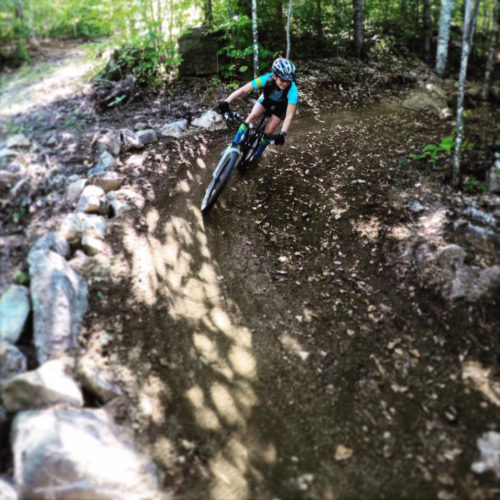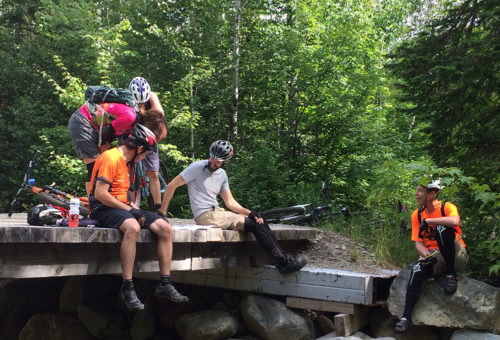Why Paper?
A paper map is meant to be used in addition to, not instead of a phone app. We can do great things with our phones, but a phone isn’t always the best tool for navigating. Here are 10 reasons why we want a paper map, too.
- We don’t need reliable cell service to use it and it never loses power. We won’t suddenly find ourselves without navigation.
- If we drop it on a rock, it won’t get smashed.
- We can navigate paper maps with muddy, full-finger gloves.
- Got context? When we make the trails on our phones as big as the trails on the paper map, we can only see a bit of what’s around—we lose the big picture. Paper maps have the big picture.
- They’re detailed and accurate. Trail intersections show an accurate placement of trails to each other. Also, they’re not vague, ambiguous or missing pieces, as app tracks often are.
- Phones are personal, and we try not to touch anything on phones that aren’t ours, but we crowd around paper maps and trace routes or point things out with our fingers. Paper maps are communal.
- These maps have useful information that we could track down or find out from friends, but why bother—it’s all right here. Plus, the ads on these maps are for things we care about.
- These maps show what’s approved for riding and what’s private or rogue—we know where we’re good to go.
- We can mark on them. Keep notes about the trails, highlight a route, or leave a message tucked under our friend’s windshield wiper.
- They’re a nice gift to friends new to the sport, or people on the trail who could use some navigation help.
Where are they available?
The first edition was free, why isn’t the second?
Advertising supported part of the costs of making the maps, but for this project to be sustainable—to continue to add new features to the maps and update trails as they change—the maps need to start paying off more of the costs associated, including 10% of maps sales going directly to trail materials and maintenance.
Who are they for?
- Experienced local riders who realize they don’t actually know all the trails, or which ones are approved for mountain biking
- Sub-groups that might split off from the main group, but don’t have a leader who knows the trails
- People new to the area, such as college students or the growing number who’ve realized they can live in Maine and telecommute
- New moms looking to get back into shape
- Runners with their kids riding bikes alongside them
- People making time (or retirees finding lots of time) to get into a sport they’ve wanted to try
How are these maps better than maps we find and print ourselves?
Many organizations have maps of their trails, but they’re not as current, detailed or accurate as these. Also, these maps are for mountain biking, so they’ve got difficulty ratings specific to mountain biking. It doesn’t take an expert to hike down a flight of stairs, but it takes an expert to bike down one. These maps will help you find routes based on your mountain-biking ability.
Who determines trail difficulty?
The orange, green, blue, and black indications of trail difficulty are provided mostly for the benefit of beginner and novice riders. Local GPNEMBA members very familiar with the trails (in each location) were asked to rate the trails with guidelines in mind.
Will the maps be available digitally?
Not at this time. These printed maps are made available through support of local shops and advertisers. In return for advertiser support, the maps need to be provided in a manner that ensures the front and back remain intact.
Do you plan to make the maps available in an interactive app?
Yes. Sign up to get news by email and you’ll be among the first to hear when this is available.
Why would someone use these maps instead of an app?
Not instead of, in addition to. See the “Top 10 Reasons for Paper Maps” on this page.
There are more trails than this, why aren’t they on the maps?
The goal of this project is to indicate every intersection—in future editions if not this one. Intersections are the primary places we refer to maps and find our location or desired route. Not all trails are okay for public use, however. Intersections with trails that are unauthorized, retired, or that just “peter out” are indicated for navigation clarity, but the routes for those trails are not shown. There will be trails that are undetermined at the time of printing. These will be revised in future editions. Comments or suggestions are welcome.
Who is doing this?
 Wendy Clark has been mountain biking in southern Maine for 25 years. She is a member of the New England Mountain Bike Association, the Bike Coalition of Maine and the Maine Outdoor Adventure Club. She is also an avid skate skier. You could say she’s experienced at wending her way through the woods.
Wendy Clark has been mountain biking in southern Maine for 25 years. She is a member of the New England Mountain Bike Association, the Bike Coalition of Maine and the Maine Outdoor Adventure Club. She is also an avid skate skier. You could say she’s experienced at wending her way through the woods.
Trained in graphic design, photography and fine art, Wendy spent 15 years working in the magazine and newspaper industry before leaving in 2009 to establish Wendy Clark Design, LLC. She now creates and designs her own products as well as materials and products for clients.
And why?
Because where to mountain bike shouldn’t be secret. Social people might like to join a group or have a guide, but that shouldn’t be the only way to find and enjoy the trails. Respectful use of apporved trails should be available to anyone who wants to have fun riding bikes in the woods.

